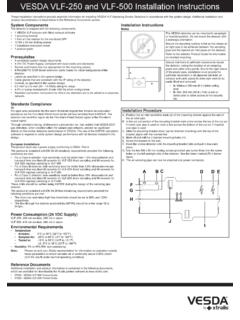Transcription of A Guide to the FIA Code of Practice - VESDA System
1 A Guide to the FIA code of Practice The best Practice design, installation , commissioning and maintenance of aspirating smoke Detector Systems Contents All sections are as per the FIA code of Practice (COP). However, some sections are not commented on by us, so will be shown as no comment in the text. The contents sections below and the head of each page in the document are colour coded for ease of navigation. These colour codes are: Specification Design installation Commissioning Maintenance A. Objective 3. 1.
2 Scope 4. 2. References 4. 3. Terms and definitions 4. 4. Introduction to VESDA detectors 4. 5. Categories of System 6. 6. Exchange of information and definition of responsibilities 7. 7. Variations of recommendations 7. 8. Design Considerations 7. 9. Design Tools 10. 10. Applications 11. 11. Product Standards and Marking 11. 12. Limitations of False Alarm 12. 13. installation 14. 14. Commissioning and Handover 16. 15. Maintenance 18. B. Appendices 19. A. Objective The objective of this document is to summarise and highlight the most important aspects of the code of Practice .
3 It is intended that it will provide a short form and quick reference Guide to anyone dealing with VESDA detectors . This will provide a basic aid that will prompt further investigation in the correct section of the code of Practice . Particular guidance on the use of VESDA detectors is provided where relevant. It is not intended that this document be used in place of the code of Practice or any other standard. 3. 1. Scope The scope is as defined on page 7 of the code of Practise (COP). The purpose of the document is to provide recommendations on all aspects of the implementation of VESDA .
4 From planning to maintenance. The COP discusses: the categorisation of systems and applications where they can be used. the performance tests that have always been applied to VESDA with the inclusion of some new and more flexible tests. The COP also has a series of forms that can be used or modified to suit, covering each process from planning to handover and on to maintenance. The COP does not advise on the size of sample pipes, capillaries or hole sizes, but does suggest that ASPIRE2 software should be used as a design tool to verify these are correctly sized.
5 This replaces the previous 1996 version of the COP. 2. References It is strongly advised that the documents described in section 2 on page 8 of the COP are referred to when using this Guide . 3. Terms and definitions No Comment. Refer to the COP. 4. Introduction to VESDA . VESDA detectors are the market leader in aspirating smoke Detection (ASD) technology and since the introduction of ASD and incorporation in to British Standards and NFPA. documents, its use has significantly increased providing a solution to a wide range of applications.
6 A VESDA System is an integral part of the overall fire System , even replacing conventional systems in certain applications (refer to ). As such, the designer must ensure compliance to National Standards. Reasons for using a VESDA detector and its applications The following three points are the principal reasons for applying ASD and reflect the classes within EN54-20. In the COP, section 10 discusses applications and we have included them in to each of the three classes here. Each heading will define the Class and each sub heading defined as a reason for using a VESDA System .
7 Very early warning (Class A). A level of detection well before conventional systems would operate. High sensitivity applications (Reason ). Computer Rooms Clean Rooms Telecommunications Process Control Machinery 4 Bio-Medical Facilities As an alternative or as an initiating device to extinguishing systems (Reason ). This includes all the areas shown above, but can also include foam extinguishing systems in areas like: A warehouse with high value stock Aircraft Hangers It is also important that Primary & Secondary detection is considered in High Sensitivity areas and this is discussed in Design Considerations, Chapter 6.
8 Enhanced smoke sensitivity (Class B). For areas where a higher level of sensitivity than normal is required, where smoke is diluted due to height. When designed to this Class, a VESDA System can be configured to operate a smoke management System or actuation of suppression systems. 4 . Large open spaces (Reason ). Shopping Atria Warehouses Cold Stores Aircraft Hangars Sports Stadia Objects that require better levels of detection (Reason ). Process Machinery Organs in Churches and Cathedrals Works of Art Business-critical Areas An alternative to point or beam type smoke detectors (Class C).
9 There are many reasons why a VESDA System is used as an alternative to conventional detection systems. The following identifies some of these areas. Restricted or difficult access (Reason ). When the area to be protected is restricted or dangerous; locating the VESDA detector outside this area provides a safer workplace for maintenance activities. Ceiling Voids EMC Areas Floor Voids High Ceilings Above process machinery Aesthetics (Reason ). Concealed detection is important for appearance or for reducing the risk of vandalism.
10 Museums Art Galleries Churches and Cathedrals Stately Homes Prison Cells Police Custody Suites Environmentally challenging area (Reason ). There are many areas that cause an environmental issue to conventional detection where VESDA can offer a suitable solution whilst avoiding false alarms and reducing maintenance demands. Areas with a high temperature Cold areas Areas with high humidity Wash down areas in food production 5. Dusty areas 5. Categories of System The COP identifies a method of defining, in a single unambiguous sentence, the System description.

